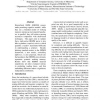Free Online Productivity Tools
i2Speak
i2Symbol
i2OCR
iTex2Img
iWeb2Print
iWeb2Shot
i2Type
iPdf2Split
iPdf2Merge
i2Bopomofo
i2Arabic
i2Style
i2Image
i2PDF
iLatex2Rtf
Sci2ools
ACL
2010
2010
Complexity Metrics in an Incremental Right-Corner Parser
Hierarchical HMM (HHMM) parsers make promising cognitive models: while they use a bounded model of working memory and pursue incremental hypotheses in parallel, they still achieve parsing accuracies competitive with chart-based techniques. This paper aims to validate that a right-corner HHMM parser is also able to produce complexity metrics, which quantify a reader's incremental difficulty in understanding a sentence. Besides defining standard metrics in the HHMM framework, a new metric, embedding difference, is also proposed, which tests the hypothesis that HHMM store elements represents syntactic working memory. Results show that HHMM surprisal outperforms all other evaluated metrics in predicting reading times, and that embedding difference makes a significant, independent contribution.
ACL 2010 | Complexity Metrics | Computational Linguistics | Incremental Hypotheses | Right-corner Hhmm Parser |
| Added | 10 Feb 2011 |
| Updated | 10 Feb 2011 |
| Type | Journal |
| Year | 2010 |
| Where | ACL |
| Authors | Stephen Wu, Asaf Bachrach, Carlos Cardenas, William Schuler |
Comments (0)

